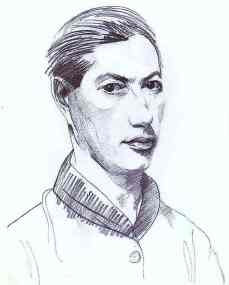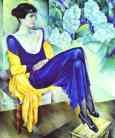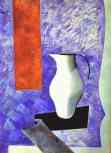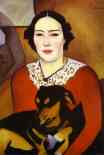Nathan Altman Biography

Nathan Isaiehvich Altman was born in Vinnitsa, a provincial town in the Malorossiyan part of the Russian Empire, now Ukraine. He lost his father early and had to count only on himself in achieving his goal to became an artist. He studied in Odessa Art School (1902-07), but left it, unsatisfied with the level of teaching. On his return to Vinnitsa, he went on working alone. At the end of 1910, he went to Paris, where he lived for about a year. The trip played an important role in his future career. His natural talent helped Altman to feel and understand the art ideas and trends of his time, and inborn professionalism helped to realize the ideas into artistic and elegant works of art. He was mostly influenced by Picasso and Braque.
At the end of 1912, the artist moved to St. Petersburg, where he painted in Cubist manner, and soon became a popular artist. His famous Portrait of Anna Akhmatova (1914) established his fame. His works in sculpture, graphics and scene designs were also a success.
After the Bolshevik Revolution (November 1917) Altman, as most artists of the ‘left’ wing started an active public life and made works of mass propaganda; sculpture works, stamps for the new Soviet state, decorations for the holidays of the 7th November 1918 on the Palace Square in Petrograd (St. Petersburg) and executed a series of graphic portraits of Vladimir Lenin, which were published in a separate album and became very popular.
Methods of close studying and skillful using of Suprematism he used in the series of pointless canvases Petrocommune, Material Collection, Russia. Labour, and others (1919-20). The following years he worked mostly in graphics, created a series of portraits of contemporary writers (1926-27) and book illustrations. Especially successful was his work in the theatre as scene designer.
In 1928 Altman left Russia for France, where he returned to painting. He painted many landscapes and still lifes, in which he originally and daintily revived the tradition of Impressionism. He illustrated several children books, Old Testament, Gogol’s Petersburg Novels, and also designed interiors. Altman returned to Russia in 1935 and found himself in a very difficult political atmosphere of ideological pressure and terror. His painting was so far away from the criteria of critical realism enforced by the Communist party, that he had to drop it altogether and was engaged only in book illustrations, which allowed him, to some extent, to remain not so prominent. The best works of that period were his scene and costume designs for Shakespeare plays King Lear (1941), Othello (1944), Hamlet (1954).
The artist died in Leningrad (St. Petersburg) in 1970.
Bibliography
Nathan Altman. By M. Etkind. M. 1971.
Nathan Altman. Catalogue of Exhibition. M. 1978.
Nathan Altman: Theatre. Cinema. Catalogue. Leningrad. 1978.
The Art and Architecture of Russia (Pelican History Art) by George Heard Hamilton. Yale Univ Pr, 1992.
A Dictionary of Russian and Soviet Artists 1420-1970 by John Milner. Antique Collectors' Club, 1993.
The Russian Avant-Garde: Art and Architecture by Catherine Cooke. St Martins Pr, 1984.
Origins of the Russian Avant-Garde by Yengenia Petrova. Palace Editions, 2003.
- Portrait Of Anna Akhmatova.

1914. Oil on canvas. 123.5 x 103.2 cm. The Russian Museum, St. Petersburg, Russia. Read Note.
- Material Painting. Still Life With A White Jug.

1919. Oil and enamel on canvas. 84.5 x 62 cm. The Russian Museum, St. Petersburg, Russia.
- Lady With A Dog. Portrait Of Esther Schwartzmann.

1911. Oil on canvas mounted on cardboard. 67.5 x 47.5 cm. The Russian Museum, St. Petersburg, Russia.